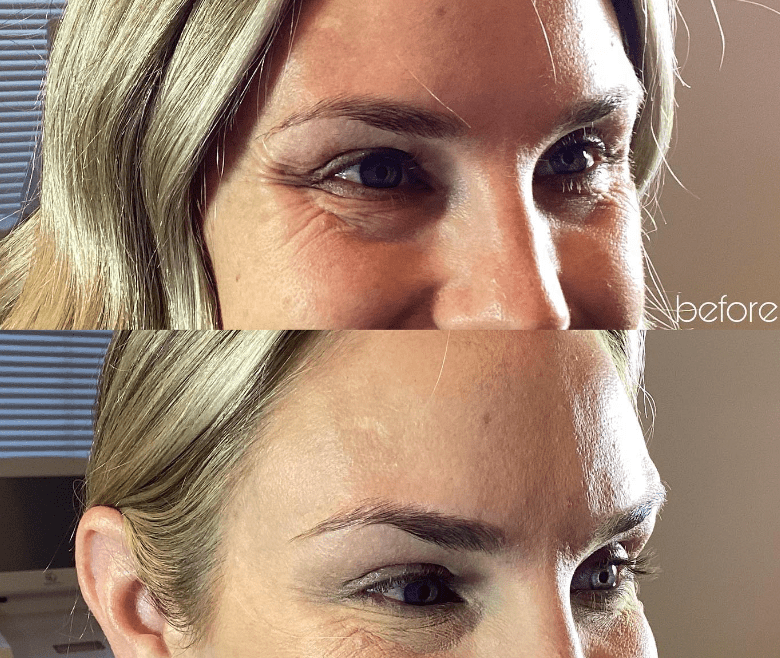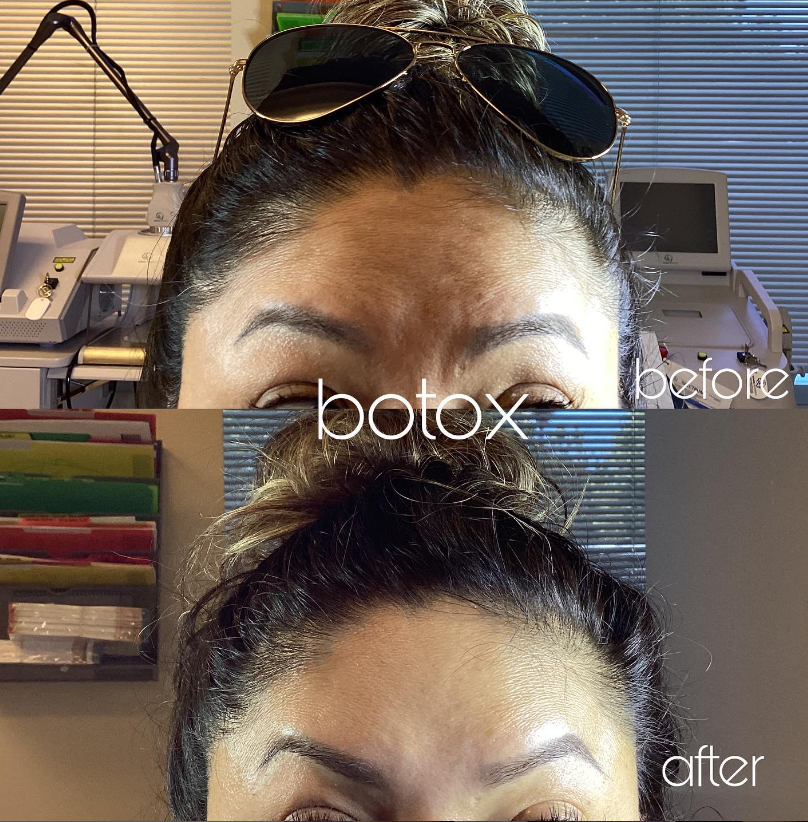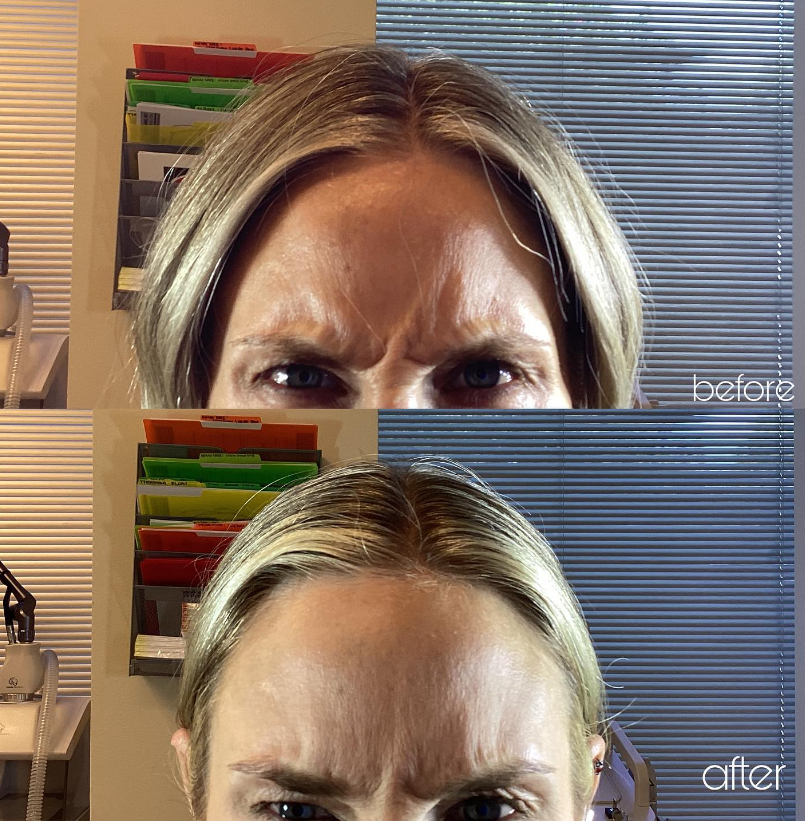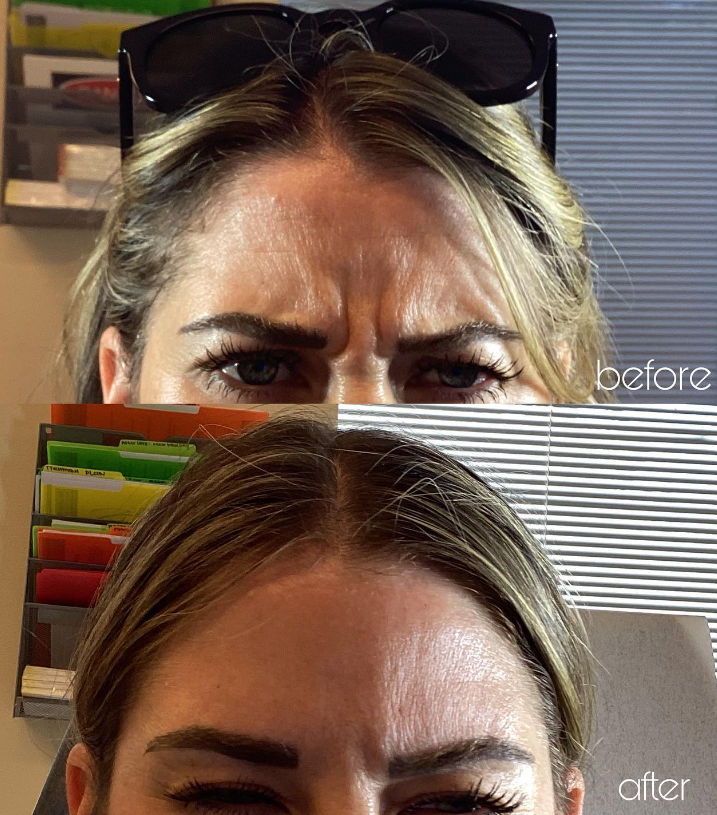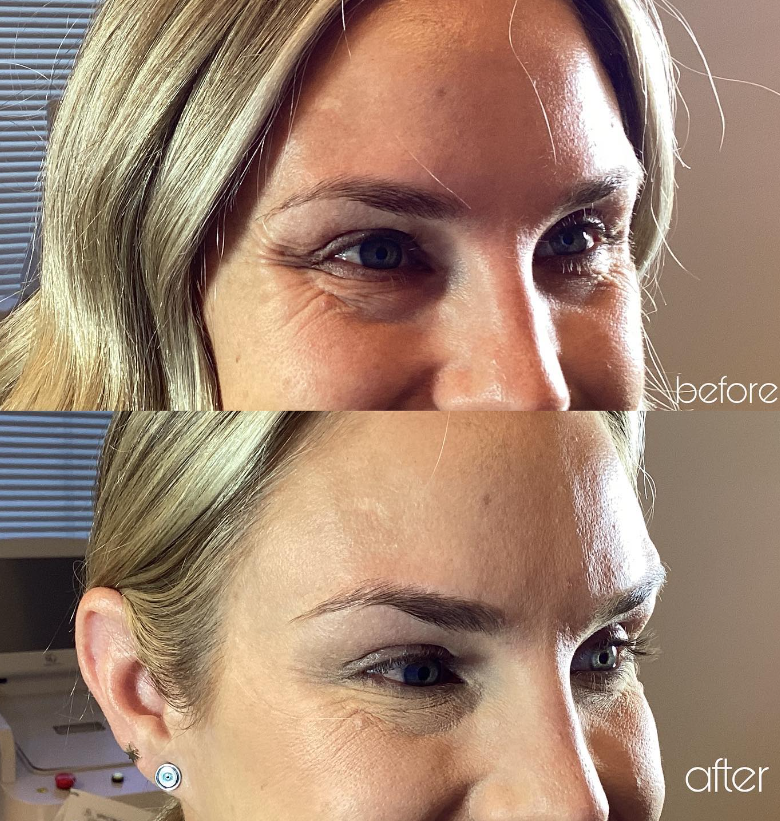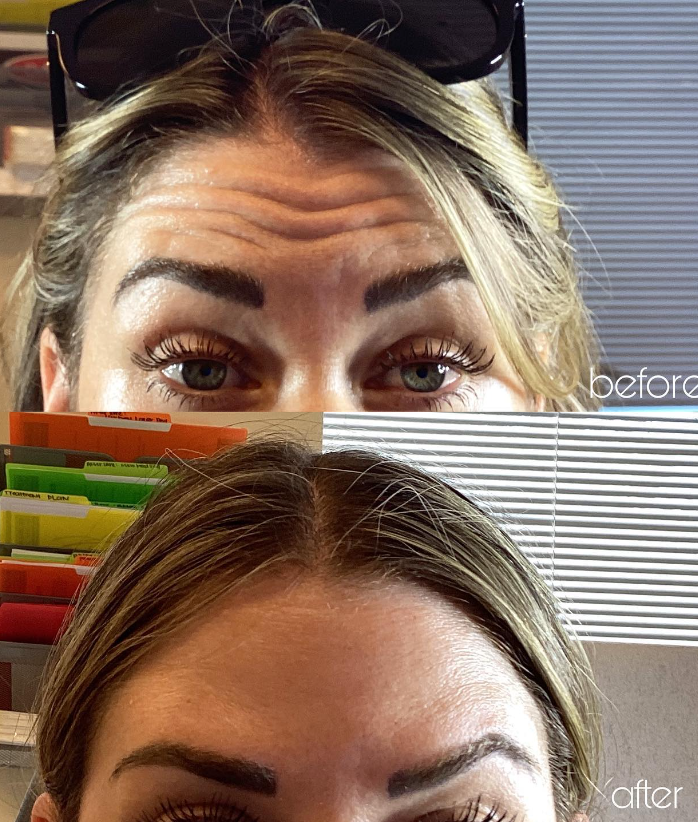
“Botox” is a trade name for a product developed by Botox Cosmetics that utilizes a refined version of botulinum toxin type A. This substance is commonly employed in medical and cosmetic procedures to temporarily lessen muscle activity, resulting in various effects based on the intended application.
Below are several typical uses of Botox:
Treatment of Facial Wrinkles and Fine Lines: Botox is frequently utilized to diminish facial wrinkles and lines arising from muscle contractions.
Glabellar Lines: These furrows manifest between the eyebrows during frowning.
Forehead Lines: These horizontal lines emerge on the forehead.
Crow’s Feet: Fine lines around the eyes’ outer corners.
Medical Applications: Botox can potentially address various muscle spasms, encompassing effectively.
Cervical Dystonia / Muscle spasms in the neck region.
Blepharospasm / Involuntary contractions of the eyelid muscles.
Spasticity / Muscle stiffness and spasms are often observed in conditions like cerebral palsy or post-strokes.
Chronic Migraine / Persistent migraines in adults. Hyperhidrosis / Excessive perspiration in the underarm area.
Strabismus / Misalignment of the eyes.
Overactive Bladder / Urinary incontinence.
Botox before and after eyes
Botox forehead before and after
Botox Crow’s feet before and after
Dysport vs Botox
Both are popular cosmetic procedures that harness the power of botulinum toxin to temporarily smooth wrinkles and fine lines, resulting in a rejuvenated appearance.
Here are several key distinctions between these products:
Active Ingredient: Both products employ distinct formulations of botulinum toxin type A as their active components. Botox possesses a larger molecular weight and complexing protein, rendering Dysport more readily absorbed by the skin and spreadable. Due to this, Dysport is cautioned against use on crow’s feet and in proximity to the eyes, as it could potentially diffuse to the eyes, causing issues like blurry vision or drooping eyelids.
Application: Both products are utilized to address dynamic wrinkles, which arise from repetitive facial muscle movements, such as those occurring when frowning, smiling, or squinting. Dysport has received FDA approval exclusively for Glabellar lines, but it can be employed in other areas under the supervision of a medical professional. Botox has gained FDA approval for Glabellar Lines / “11” lines between the eyebrows, horizontal forehead lines, crow’s feet / fine lines around the outer corners of the eyes, and lateral canthal lines / extending from the outer corners of the eyes, often known as “smile lines” or “laugh lines.”
Effectiveness, Onset, and Duration: The effectiveness of both products is generally deemed comparable. Both treatments yield noticeable results by diminishing the appearance of wrinkles and fine lines for approximately 3 to 4 months in most individuals. Botox’s effects start manifesting within seven days and reach full impact within two weeks, whereas Dysport’s effects commence after four days and fully develop within two weeks. However, individual responses may vary.
Spread and Dispersion: Dysport could exhibit slightly wider spread or diffusion than Botox, potentially advantageous for treating larger areas or specific wrinkles. However, this might necessitate a skilled injector to ensure precise outcomes.
Units and Pricing: The impact of one unit of Botox is akin to that of two units of Dysport. We present highly appealing prices for both products. For further details, you can explore our appointments page. Patient Experience: The overall experience of undergoing Dysport or Botox injections is generally similar. Both procedures involve injections, and minimal discomfort might be experienced. Patient preferences regarding the “sensation” of the injection might differ, though this is subjective.
Immunity: In cases where an individual’s immune system generates antibodies against the botulinum toxin or its accessory proteins, diminished or no response to the treatment can occur over time. However, developing immunity to one botulinum toxin-based product doesn’t necessarily imply immunity to others. If immunity arises, alternative treatments or approaches like switching from Botox to Xeomin or Dysport may need exploration. Conversing with a qualified healthcare provider is crucial for tailored advice based on medical history and individual requirements.
Why consider Botox?
There are several compelling reasons why individuals may contemplate undergoing Botox treatments. This is a cosmetic procedure involving injecting a purified form of botulinum toxin type A, which presents various advantages for cosmetic and medical purposes. Here are several common motivations for considering this product:
Wrinkle Reduction: This product is renowned for diminishing fine lines and wrinkles in areas prone to muscle movement, such as the forehead, the region between the eyebrows, and the vicinity around the eyes.
Youthful Visage: Botox can soften wrinkles and restore a smoother complexion, contributing to a youthful appearance.
Proactive Approach: Some individuals choose Botox as a proactive measure, commencing treatments earlier to forestall the formation of deeper wrinkles.
Boost in Confidence: Enhancing physical appearance can elevate self-confidence and foster a positive self-image.
Non-Invasive Nature: This product is a prevalent choice for non-invasive cosmetic enhancements.
Swift Procedure: Botox treatments can be seamlessly incorporated into busy schedules due to their brief duration.
Minimal Recovery Time: Following the treatment, recipients are generally advised not to lie down or manipulate the treated area for six to eight hours to prevent the inadvertent spread of Botox to adjacent regions. Other than this precaution, individuals can resume regular activities shortly after the procedure. Many appreciate that Botox treatments typically entail minimal to no recovery time.
Tailored Outcomes: Proficient practitioners can customize this treatment to achieve natural results and harmonize with each individual’s distinctive features.
Medical Applications: Beyond its cosmetic uses, this product finds various medical applications, including addressing muscle spasms, migraines, excessive sweating (hyperhidrosis), and specific bladder and ocular conditions.
Temporary Effects: The effects of Botox are temporary, typically lasting around 3 to 4 months on average. This feature can particularly appeal to those who wish to explore a cosmetic treatment without committing to permanent alterations.
Acknowledging that each individual’s motivations for contemplating Botox can be highly individualized is crucial. If you want this procedure, seeking consultation from a qualified healthcare provider or medical professional is recommended. They can evaluate your objectives and offer personalized counsel on whether this product suits your circumstances.
What are the pre-care instructions for Botox?
Avoiding Blood Thinners: Before your treatment, it’s recommended to steer clear of blood-thinning medications and supplements to reduce the risk of bruising and bleeding. However, always consult your healthcare provider before discontinuing any prescribed medications.
Steer Clear of Alcohol: To mitigate the possibility of bruising, refraining from alcohol consumption for a few days before your treatment is advisable.
Stay Hydrated: Ensuring adequate hydration by drinking plenty of water before your appointment can help maintain skin moisture and aid healing.
Prioritize Skin Care: On the day of your treatment, skip the makeup and focus on maintaining clean skin, particularly in the areas slated for treatment.
Provide Full Information to Your Provider: During your consultation, it’s important to divulge all relevant information about your medications, medical history, and any previous cosmetic procedures. This information is crucial for ensuring your safety and devising an appropriate treatment plan.
Notify About Allergies: If you have allergies, especially to components within Botox, communicate this to your provider.
Comprehensive Medical History: A comprehensive medical history is paramount when seeking Botox treatments. This includes disclosing any neuromuscular disorders like myasthenia gravis or Lambert-Eaton syndrome, as certain conditions may impact your eligibility for treatment.
Pregnancy and Breastfeeding Considerations: If you are planning a pregnancy or are currently breastfeeding, consulting your healthcare provider before scheduling a Botox treatment is essential. The full implications of Botox on pregnancy and breastfeeding are not yet fully understood.
Choose Comfortable Attire: Opting for comfortable clothing that facilitates easy access to the treatment areas, if necessary, is advisable.
Consider Cold Compress: To minimize bruising post-treatment, applying a cold compress to the treated area for at least 20 minutes before your appointment can be helpful. Wrap an ice pack in a towel and gently place it on the area.
Realistic Expectations: While neurotoxin treatments can mitigate wrinkles and signs of aging, individual results and experiences may vary. Sustaining benefits necessitate follow-up treatments; mild discomfort or redness might occur post-injection.
Initial Nervousness: Feeling a bit apprehensive during your initial appointment is normal. Be reassured that this procedure is safe, minimally invasive, and generally entails minimal discomfort.
What are the post-procedure instructions for Botox?
After undergoing a neurotoxin treatment, it’s important to refrain from touching the treated area or the injection sites. This precaution is necessary to prevent the neurotoxin from spreading to unintended parts of the face, potentially leading to issues such as drooping eyes or swelling.
As advised by most injectors, avoiding touching your face for a minimum of six hours following the treatment is recommended.
To optimize your results, maintaining an upright and straight posture for four hours post-procedure can help prevent the neurotoxin from migrating to other facial areas.
Physical activities should be postponed for at least four hours after the treatment. In comparison, waiting 24 hours before participating in vigorous exercise or strenuous workouts is generally advisable. Lastly, refraining from blood-thinning agents like aspirin after the neurotoxin treatment is crucial for a safe and effective recovery.
Smoking after neurotoxin treatment can compromise the longevity of your results. Non-smokers typically experience longer-lasting outcomes when addressing perioral wrinkles. Abstaining from smoking enhances the potential for superior and more enduring anti-aging effects. Smoking after neurotoxin treatment can expedite results fading and even counteract treatment benefits. Many patients choose to quit smoking after neurotoxin treatment due to the presence of skin-aging-accelerating chemicals in cigarette smoke, which can also contribute to other health issues.
It’s advisable to avoid alcohol consumption both before and after a neurotoxin treatment, as alcohol can thin the blood and potentially lead to complications. This effect is comparable to the impact of blood-thinning medications. Consuming alcohol post-treatment may heighten the risk of bruising, while alcohol intake before or after the injections can elevate the chances of significant bleeding at the injection site.
Following neurotoxin injections, abstaining from facial treatments and massages for a week is crucial. This is because facial massages can disrupt the even distribution of the neurotoxin on your face, leading to its migration to unintended facial areas. Applying pressure to your face or receiving facial massages should be avoided for at least four hours after the treatment.
Moreover, numerous facial treatments contain potent chemicals that could interfere with the effects of neurotoxin injections. Hence, it’s advised to refrain from facials, masks, and chemical peels for at least a week post-procedure. If you’re contemplating a facial treatment, you should inquire about the recommended time after your neurotoxin appointment. This approach minimizes the risk of potential complications.
How long does the Botox treatment last?
Neurotoxins can reduce wrinkles, lines, and folds on the face. Their effects last for three to four months but can be affected by sun exposure, smoking, and alcohol. Consult with your doctor for guidance on appointments and touch-ups.
How long will it take to get the Botox results?
Botox results start showing up one week after the treatment. The neurotoxin results will show completely in 2 weeks after your treatment. These results will usually last between two to five months, depending on the individual.
Xeomin vs Botox
These are both popular cosmetic treatments that use different forms of botulinum toxin to reduce the appearance of wrinkles and fine lines temporarily. While they are similar in many ways, there are also some differences between these products:
- Active Ingredient: Both products contain different forms of botulinum toxin. Xeomin lacks complexing proteins, while Botox has accessory proteins associated with the toxin.
- Formulation: Xeomin contains only active botulinum toxin, making it simpler. Some prefer it due to its potential to reduce the risk of developing resistance to treatment. It is also useful for individuals with antibodies to complexing proteins found in Botox or Dysport.
- Onset and Duration: Xeomin starts to act 3 – 4 days after treatment, whereas Botox takes seven days to start showing some impact. The duration of effects for both treatments is typically around 3 to 4 months on average, though individual experiences may vary.
- Spread and Diffusion: Xeomin is a lightweight product compared to Botox; hence, it is not recommended to be injected near the eye on the crow’s feet or brow lift.
- Units and Pricing: The units of these products needed for a specific treatment area might not be directly equivalent. We provide very competitive prices for both the products. You can check our appointments page for more information.
- Patient Experience: The overall experience of receiving both product injections is generally similar. It is important to note that Xeomin has fewer allergic reactions than Botox as it contains less complex proteins. Both treatments involve injections, and there might be minor discomfort during the procedure. Some individuals may have personal preferences based on their experiences.
- Immunity: Developing immunity to one botulinum toxin-based product does not necessarily mean immunity to others. If immunity does occur, alternative treatments or approaches may need to be explored with a healthcare provider, like switching the product from Botox to Xeomin or Dysport and vice versa.
Botox specials
We take pride in offering highly competitive pricing, and at present, we have ongoing promotions for Botox, Xeomin, and Dysport treatments. To access our pricing details, visit our ‘book online’ page.
Why should I consider doing Botox in Dublin with you?
At our clinic, Dr. Garg personally administers all cosmetic injections. She conducts comprehensive consultations with patients, carefully reviewing their medical history to assess any potential impact on treatment results. She devises a tailored treatment strategy using your facial characteristics as a guide. After obtaining patient consent for the proposed plan, she skillfully administers the Botox treatment according to the agreed-upon approach. With her meticulous approach, Dr. Garg prioritizes safety and aims to minimize the risk of side effects and undesired results.
Where can I check the pricing on Botox and book an appointment?
You can get more information on Botox, Dysport and Xeomin at this page. We have a book online page to check prices and book appointments online.
About Dublin
Greetings and welcome to the beautiful city of Dublin, California – a charming locale nestled in the heart of the East Bay Area. With its rich history, diverse culture, and modern amenities, Dublin offers an ideal balance of urban living and natural beauty.
Originally established as a small farming community in the 19th century, this city has since transformed remarkably into a thriving hub of economic growth and community spirit. Situated between the bustling metropolises of San Francisco and San Jose, Dublin boasts a prime location that appeals to those seeking a well-rounded and fulfilling lifestyle.
Experience all that this wonderful city has to offer!
Patient Reviews
I have been using the services of Dr Anuja Garg as my physician and weight loss specialist since March 2024.
We decided to follow the clinic weight loss program after taking all the necessary precautions. 10 weeks in; I have lost rather effortlessly 55 pounds.
I fully trust Dr Garg and her team to monitor my health during my weight loss journey and beyond.
I highly recommend the clinic.
Overall a good experience, I will recommend this if you want to get medicals done for immigration

